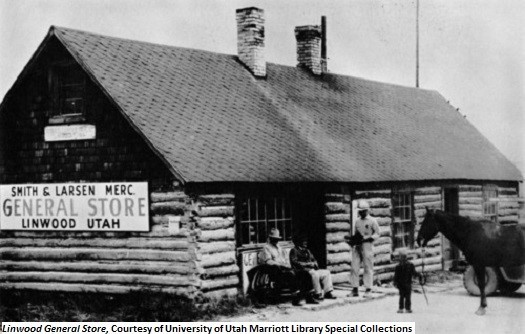Dublin Core
Title
Description
Every summer, thousands of people flee to the cool waters of Flaming Gorge Reservoir in Utah’s northeast corner. But few of them would know about the little town of Linwood buried beneath the water’s surface.
Linwood grew near the confluence of Henry’s Fork and the Green River, right on the Utah-Wyoming border. The mouth of Henry’s Fork was long a gathering place for trappers, traders, and explorers, but it wasn’t until the 1890s that a man named George Solomon surveyed the spot for a town site. He named it “Linwood” for all the cottonwood trees in the area.
It was an easterner named Keith Smith, however, whose family purchased the Linwood site in 1902 and got the town going. The Smiths established a post office for the area’s farms and ranches, and started businesses to serve those brought by the booming sheep industry. Along with their neighbor Marius Larsen, the Smiths built mercantile stores, hotels, and even a dance hall. Also popular was Bob Swift’s Bucket of Blood Saloon where liquor, gambling, and women attracted wild and woolly crowds, including outlaws and sheepmen who liked to party and had money to spend. Linwood was a lively place.
Linwood was also home to the unusual “Stateline” School, built on the state boundary in 1904, with the north half of the building in Wyoming and the south half in Utah. A favorite story still told about the Stateline School is that when corporal punishment was not allowed in one of the two states, teachers would escort disobedient students to the appropriate side of the building for reprimand.
Linwood thrived during first decades of the twentieth century, but by the 1920s the sheep boom that had sustained its bustling commerce, waned due to overgrazing. When Flaming Gorge Dam was built in the early 1960's, the rising water of the reservoir drowned the little town.
Creator
Source
Image: Linwood General Store. The Smith and Larsen Mercantile in Linwood, Utah, was razed in preparation for the flooding of Flaming Gorge. Courtesy University of Utah Marriott Library Special Collections.
_______________
See “Linwood: The Town that Drowned”, Monuments and Markers Database, Utah Division of State History, http://history.utah.gov/research_and_collections/markers/index.html; Michael W. Johnson with Robert E. Parson and Daniel A. Stebbins, A History of Daggett County: a Modern Frontier, Utah Centennial County History Series from the Daggett County (Utah) Centennial Commission, Salt Lake City: Utah State Historical Society, 1998; Roy Webb, “I Had Arrived at Perfection: The Lost Canyons of the Green River,” Utah Historical Quarterly (volume 79, number 1, Winter 2011), pp. 4-19; Donald Weir Baxter, "The History of Public Education in Daggett County Utah and Adjacent Areas," Master's thesis, Brigham Young University, 1959, pp. 50-52.

